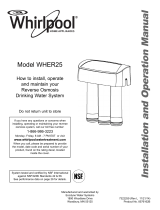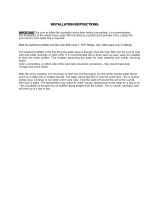
6
Using the Reverse Osmosis System
USING THE REVERSE OSMOSIS SYSTEM: How the System Works
How the Reverse Osmosis System Works
Reverse Osmosis reduces Total Dissolved Solids (TDS) and organic matter from water by diffusing it through a
special membrane (see Performance Data Sheet). The membrane separates minerals and impurities from the water
and they are flushed to the drain. For the reduction of the claims specified, see Performance Data Sheet. High
quality product water goes directly to the drinking water faucet or to the storage tank. The system makes a good
supply of drinking water each day. How much it makes depends on the feed water supply pressure, temperature
and quality.
The prefilter and postfilter are replaceable cartridges. The carbon prefilter reduces chlorine while also filtering
sediments. The postfilter reduces any other undesirable tastes and odors before you use the water.
The system includes an electronic faucet assembly with a prefilter and postfilter change reminder. When six months
have passed, a flashing light will remind you to change the two filters.
Description of the Reverse Osmosis System
Prefilter - Water from the cold supply pipe is
directed to the prefilter cartridge. The prefilter is a
replaceable sediment cartridge containing activated
carbon. The prefilter reduces chlorine taste and odor
in the feed water because CHLORINE DESTROYS
THE REVERSE OSMOSIS MEMBRANE. Filtered,
clean, chlorine-reduced water flows from the prefilter to
the Reverse Osmosis cartridge.
Reverse Osmosis Cartridge - The middle
cartridge includes a tightly wound, special membrane.
Water is forced through the cartridge where the
membrane reduces the dissolved solids and organic
matter. High quality product water exits the Reverse
Osmosis cartridge and goes to the storage tank.
Reject water, with the dissolved solids and organic
matter, leaves the cartridge and is discharged to the
drain through 1/4” tubing.
Storage Tank - The storage area holds up to 1-3/4
gallons of product water. A diaphragm inside the tank
keeps water pressurized, when the tank is full, for fast
flow to the faucet when drinking water is needed.
When the tank is empty of water, the pressure at the
air valve is 5 - 7 psi.
Postfilter - After leaving the storage tank, but before
going to the system faucet, product water goes to the
post filter cartridge. The postfilter is an enhanced
replaceable sediment cartridge containing activated
carbon designed to reduce select pharmaceuticals,
select herbicides/pesticides, VOCs, BPA and PFOA/
PFOS as well as remaining tastes, odors, and
sediments. Clean, high quality drinking water flows
through the tubing and to the system faucet.
RO Product Water Faucet - The countertop
faucet dispenses filtered drinking water when opened.
It has a variable flow handle. To comply with plumbing
codes, an air gap is built into the faucet drain water
connection.
Faucet Electronics - Inside the faucet handle is a
battery operated 6 month timer. The faucet LED will
light blue for a few seconds whenever the faucet
handle is operated. When 90% of the filter lifetime has
elapsed, the LED will flash blue 3 times whenever the
faucet handle is operated. It will flash red continuously
when 100% (6 months) has elapsed, to indicate that
the prefilter and postfilter cartridges must be changed.
Automatic Shutoff Assembly - To conserve
water, the drinking water system has an automatic
shutoff. When the storage tank has filled to capacity
and the drinking water faucet is closed, pressure
closes the shutoff. Water flow to the Reverse Osmosis
cartridge is shut off until drinking water is used again,
and pressure drops in the Reverse Osmosis system.
Check Valve - The check valve in the manifold
assembly prevents a backward flow of product water
from the storage tank. A backward flow could cause
the Reverse Osmosis membrane to rupture.
Flow Control - The flow control regulates the flow
of water through the Reverse Osmosis cartridge at the
required rate to produce high quality water. The
control is located in the elbow fitting where the red 1/4”
drain line exits the manifold.





















